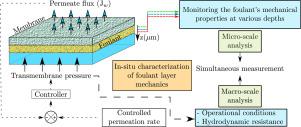Journal of Membrane Science ( IF 8.4 ) Pub Date : 2021-08-24 , DOI: 10.1016/j.memsci.2021.119747 José A. Epstein 1 , Guy Z. Ramon 2

|
Fouling remains an operational limitation in membrane-based water purification. Despite extensive research on fouling, little is known about the mechanical properties of foulant deposits, their response to operating conditions and how these relate to fouling reversibility and resistance to permeation. Here, we demonstrate in-situ measurements of the micro-scale rheology of a foulant layer deposited at a membrane surface. A custom-made membrane cell was employed, fabricated with an optical window to enable high-resolution, real-time observation with a confocal microscope. Permeate flux and applied pressure were accurately maintained using a software-based controller. A particle-tracking technique was employed to assess the mechanical properties at different depths within the foulant layer. Through the analysis of particle trajectory statistics, the mechanical properties of the alginate layer are obtained in terms of the frequency-dependent storage and loss modulus. Importantly, this method enables the simultaneous measurement of foulant layer micro-mechanics and its macroscopic manifestation — the hydraulic resistance during filtration. Results demonstrate the elastic-gel characteristics of the foulant layer, and the variations in its storage and loss moduli upon flux increase, indicating micro-scale ‘stiffening’ of the material, as it undergoes compaction. In addition, the observed increase in the complex viscosity coincides with an increase in the hydraulic resistance. The foulant properties also exhibit clear depth variations, where the foulant’s apparent ‘stiffness’, as manifested by its complex viscosity, increases at closer proximity to the membrane surface. The presented approach provides fundamental insight and opens new possibilities for studying foulant mechanical properties, in-situ, which can lead to more effective cleaning and back-pulsing strategies for foulant removal, e.g., by selecting the most appropriate frequency and intensity.
中文翻译:

膜表面污垢层的原位微流变学
污垢仍然是基于膜的水净化的操作限制。尽管对污垢进行了广泛的研究,但对污垢沉积物的机械特性、它们对操作条件的反应以及这些与污垢可逆性和抗渗透性之间的关系知之甚少。在这里,我们展示了沉积在膜表面的污垢层的微观流变学的原位测量。使用定制的膜电池,并带有光学窗口,以便使用共聚焦显微镜进行高分辨率、实时观察。使用基于软件的控制器准确保持渗透通量和施加的压力。采用粒子跟踪技术来评估污垢层内不同深度的机械性能。通过对粒子轨迹统计的分析,藻酸盐层的机械性能是根据频率相关的储能模量和损耗模量获得的。重要的是,这种方法可以同时测量污垢层的微观力学及其宏观表现——过滤过程中的水力阻力。结果证明了污垢层的弹性凝胶特性,以及其存储和损耗模量随通量增加的变化,表明材料在经历压实时发生了微观“硬化”。此外,观察到的复数粘度的增加与水力阻力的增加一致。污垢特性还表现出明显的深度变化,其中污垢的表观“刚度”,如其复数粘度所示,在靠近膜表面时增加。











































 京公网安备 11010802027423号
京公网安备 11010802027423号